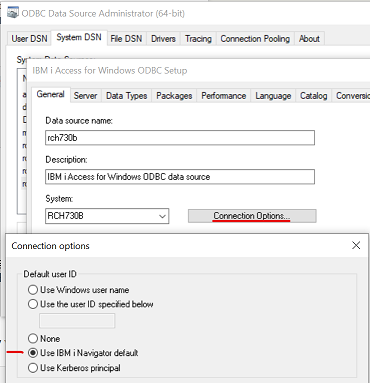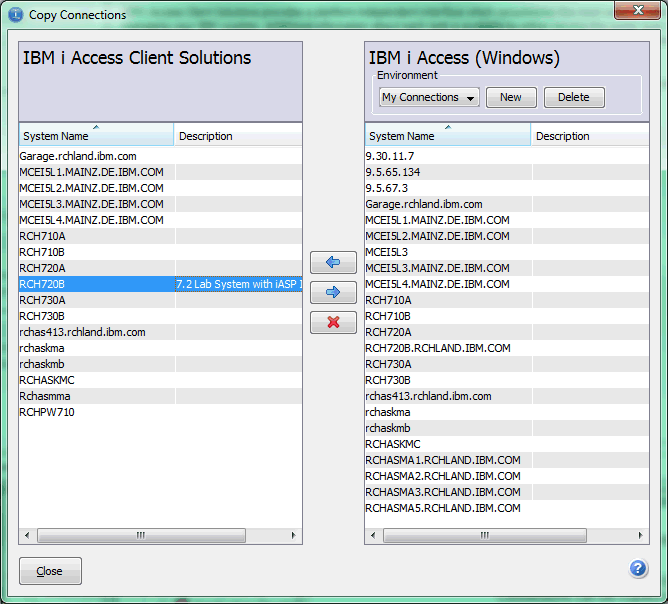Question & Answer
Question
This document describes various methods to create IBM i connection objects for the ACS Windows Application Package.
Cause

Answer
To make a connection from the ACS (Access Client Solutions) Win AP (Windows Application Package) client to an IBM i, a connection object must first be configured. These connection objects define the system and set a default user profile for the connection.
There are several ways to create one or more connections:
1) With both the java-based ACS package and the Win AP installed, copy the existing connections from the java product to the Win AP.
Start by defining the system in the java client. In the IBM i Access Client Solutions main window, select 'System Configurations' under Management. If you are defining a new connection, click the 'New' button; otherwise, select the system you wish to change and press the 'Edit' button. For example, I want to define a new connection to one of my 7.2 partitions and use a default user id of MIKSWENS and prompt for the password once per Windows login. There are 4 possible connection types shown in Fig. 2. The 'Use shared credentials' option translates to 'Use Windows user name and password, no prompting" in the Windows environment. Define the system on the 'General' tab (see Fig. 1), then define the connection properties on the 'Connection' tab (See Fig. 2).


Click the OK button on the 'Add New System' Window and the Close button on the 'System Configurations' window.
Select 'Copy Connections' from the File menu in the main ACS window. Connections can be copied into the IBM ACS Windows Application Package by selecting them on the left side of the window and pressing the right-pointing arrow to copy them to the Windows Application Package (See Fig 3.).

2) Define the connection on first use. When a system needs to be defined for a user, simply define that system in the interface that they are using. Most commonly that would be in an ODBC data source but the same concept applies to APIs or other connection types - simply define the system (host name or IP address). The first time that the connection is used by a particular Windows user, the user is prompted for the default sign-on mode for that system. For example, I create a new data source and for the System, I type in ATESTBOX. The first time that data source is used to connect to ATESTBOX, the prompt shown in Fig. 4 is displayed. Whatever selection is made there is saved as the default sign-on mode to ATESTBOX for this windows user.

NOTE: Not all applications allow prompting for credentials and some applications (Eg., MS ODBCTest) require specification of an ODBC DSN. The DSN defines the connection options in that case.
3) Back up your IBM i Access for Windows system configuration list with the command:
C:\> cwbback <fileName>
Then, restore it in IBM i Access Client Solutions by using the following command.
C:\> cwbrest <fileName>
4) Use the CWBCFG console application from a Windows Administrator-level command prompt to add or change configuration information for all users defined on a Windows system. Note: the use of this option to define a connection with a default user in a multi-user environment causes every Windows user to use the same USRPRF to connect to the IBM i. Multi-user environments must consider option 1 or 2 instead.
You can add or change the IBM i server connection definition, which includes specifying the hostname, TCP/IP address, and default user ID. The connection appears in the list of connections in WinAP Properties; Passwords tab, in the current environment for all users of the PC.
Syntax
CWBCFG [/host hostname] [/ipaddr address] [/uid userid] [/fips switch] [/ssl switch] [/dns] [/pc5250path path] [/del] [/r] [/s]
Parameter Description
/host |
Designates the connection name in System i Navigator. |
/ipaddr |
The address can be the actual IP address of the host, or one of the following: *ALWAYS - look up the address every time a connection is attempted *HOURLY - look up the address when an hour expired since last lookup *DAILY - look up the address when a day expired since last lookup *WEEKLY - look up the address when a week expired since last lookup *STARTUP - look up the address when Windows is started Note: If the IP address is specified, the IP address lookup frequency is Never, since the specified address is used. |
/uid |
Designates the user ID to use for connections to this server. Valid values are:/uid userid - where userid is the default user ID. |
| *WINLOGON - defaults to using Windows logon security *PROMPTALWAYS - prompts at least once each time you run a program *KERBEROS - use Kerberos principal name, no prompting |
|
/fips |
0 to turn off FIPS mode, or 1 to turn it on |
/ssl |
0 to turn off SSL mode, or 1 to turn it on |
/dns |
Enables DNS search to look up the IP address for the host name |
/pc5250path |
Has no effect on the ACS WinAP |
/del |
Deletes existing configuration |
/r |
Replaces existing configuration information |
/s |
Configures the host only in .default (mainly for services) |
Example
To define a connection to system YourHostName so that it is defined for all users on the system to prompt for a password each time:
CWBCFG /host YourHostName /uid *PROMPTALWAYS /r
This command replaces the existing configuration information for all Windows users on the machine.
Notes:
| 1. | The command can be run only by an administrator on Windows. On Windows 10, WindowsKey+X ; Command Prompt (Admin) |
| 2. | When you add a connection, the /s parameter enables the ODBC Driver for use from Windows service programs that run under the Local System account. |
| 3. | If no parameters are specified with the command, all Default User profile system configuration entries are displayed. |
| 4. | Specify the TCP/IP address only when the hostname is not defined on a domain name server (DNS) or in a host table entry. |
| 5. | Windows 7 and later can give unpredictable results when you use the /s parameter. The /s is used for services. |
Related Information
Was this topic helpful?
Document Information
Modified date:
14 November 2023
UID
nas8N1021929